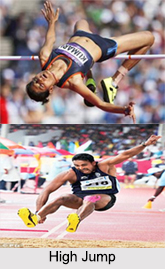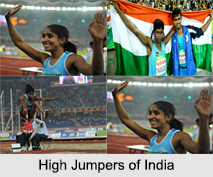 High jump is actually a track event where athletes must jump over a horizontal bar placed at measured heights without the aid of specific devices. In its modern most practised format, auxiliary weights and mounds have been used for assistance; rules have changed over the years. This game has been a part of the Olympic games of ancient Greece. From colonial era, India and other South Asian countries are participating in high jumps. Even the paralympic athletes in India have recorded their achievements in high jumps.
High jump is actually a track event where athletes must jump over a horizontal bar placed at measured heights without the aid of specific devices. In its modern most practised format, auxiliary weights and mounds have been used for assistance; rules have changed over the years. This game has been a part of the Olympic games of ancient Greece. From colonial era, India and other South Asian countries are participating in high jumps. Even the paralympic athletes in India have recorded their achievements in high jumps.
History of High Jump
As per records the first ever high jump actually took place in Scotland during 19th century. Previously, the jumpers either used prolonged straight-on approach or a scissor technique. In case of latter, the bar approached diagonally, then the jumper, after throwing the inside leg threw the other leg over the bar in a scissoring motion. The techniques began to develop with 20th century starting with the Irish-American Michael Sweeney`s Eastern cut-off. For most part of the 20th century this game was dominated by the Americans who had learned the art through experimentation and practice.
Rules of High Jumps
The rules for the high jump are set internationally by the International Association of Athletics Federations (IAAF). The jumpers must take off on one foot. A jump is measured as a failure if the bar is displaced by the feat of the jumper whilst jumping or the jumper touches the ground or breaks the plane of the near edge of the bar before clearance. The technique one uses for the jump must be almost flawless in order to have a chance of clearing a high bar.
High Jump Shoes
The shoes used in high jump are different from the ones used in case of other track events and field events. In case of high jump the shoes used have much thicker soles than ordinary "sprint spikes". This is provided in order to provide comfort and stability at the time of take off and there are also an added four holes in the heel of the take off shoe, where the user, for increased traction, inserts spikes.
As per the rules of IAAF the total number of spikes in the sole can not exceed 11, and in case of jump shoes the spikes are allowed with six or seven in the front, and four in the heel. As the rear spikes are placed only in take off shoes, so jumpers while buying must clarity of they want a right or jump pair. The four heel spike help immensely in the last four to five steps of J-approach. It aids the jumper to run on his or her curve at great speed without slipping.
Technologically also the high jump shoes are well developed, as in addition to the extra spikes on the heel, the shoes are well modified to lean the direction of approach to provide further support while running their curve. High jump shoes are also made in order to ensure that it helps the jumper to take-off. The IAAF regulations specify a maximum sole thickness for both high jump and long jump shoes; competitors in all other events may wear shoes with soles of any thickness.
Approach of High Jump
Approach of high jump is extremely crucial and is far more important than take off. In case a high jumper runs with a wrong timing or with lack of aggression, successfully clearing the high bar gets difficult. The approach demands a particular curve and shape, the right amount of speed and correct strides. The approach angle is also critical for optimal height.
All successful straddle jumpers generally run at an angle of 30 to 40 degrees, and the length of the run is mainly determined by speed of a person`s approach. Around 8 strides are required for slower runs. But a faster run may need 13 strides.
The J approach helps for horizontal speed -the ability to turn the air and good take off position. Athlete should lean from the ankles on the curve, not heel, and run tall. Their J-approach run must be adjusted slightly so that their take-off spot is slightly further out from the bar in order to allow their hips to clear the bar while still maintaining enough momentum to carry their legs across the bar. Jumpers attempting to reach record heights commonly fail when most of their energy is directed into the vertical effort, and they brush the bar off the standards with the backs of their legs as they stall-out in mid-air.
High Jumpers in India
Some of the Indian successful high jumpers are Bobby Aloysius, Sahana Kumari, Suresh Babu, Varun Singh Bhati, Vijay Singh Chauhan, Nikhil Chittarasu, Sharad Kumar, Gurbachan Singh Randhawa, Hari Shankar Roy, Ajit Singh Balla and Jithin Thomas.



















